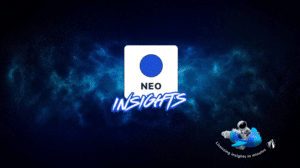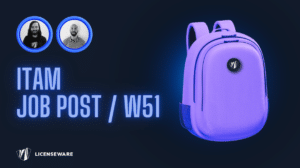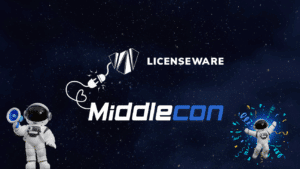📘 ITAM Is Evolving Rapidly: Why Keeping Pace with ITAM’s Evolution is Crucial for Your Career

While still a recruiter, Shaun began conversations with the ITAM Review and ITAM Forum to assess the ITAM skills gap. Sharing ideas on how to bridge it and spotlighting the most in-demand capabilities.
But after years in the field, he came to a different realisation as to why the skills gap is growing.
The real issue facing ITAM isn’t a lack of technical know-how; it’s a mindset lag.
We have always known how to manage the growing scope of ITAM. We just didn’t shift fast enough to use it.
📅 This article was written in March/April 2025 and updated to reflect major announcements such as the formal alignment between the ITAM Forum and FinOps Foundation.
Why Keeping Pace with ITAM’s Evolution Is Crucial for Your Career
I’ve seen numerous articles and podcasts discussing how quickly IT Asset Management (ITAM) is changing, often faster than professionals can comfortably adapt outside of traditional ITAM. Following ten years as a specialist recruiter within ITAM, I engaged with industry professionals at every level – from fresh graduates to senior leaders, across organisations with varying degrees of ITAM maturity. One constant observation was the widening skills gap, driven by accelerating global demand for skilled ITAM practitioners and the rapidly expanding scope of the profession (Licenseware ITAM Population Estimation).
And yet, after hundreds of interviews, I noticed a pattern: most professionals were adapting slower than the tech around them. ITAM is evolving, and quickly. Let’s explore how we can effectively keep up with the increasing scope and rising expectations placed on IT Asset Managers. Reflecting on missed opportunities from the past decade, we now have the chance to proactively shape ITAM’s strategic influence within organisations.
📈 Skill Up! Traditional Core ITAM Skills Alone Aren’t Enough
Historically, core ITAM expertise revolved around software licence analysis and in-depth vendor-specific knowledge, especially of Tier 1 vendors. However, focusing solely on software licensing is now outdated. Modern ITAM is multifaceted, covering:
- SaaS Management
- FinOps (Cloud Cost Management)
- Security
- GreenOps
- Cloud Migration
- AI Oversight
These additional responsibilities have introduced both incredible opportunities and substantial challenges. My unpopular opinion is that most of the ITAM community has failed to capitalise on these newer opportunities.
📉 Most ITAM Professionals Missed the SaaS and FinOps Wave
Could history repeat itself?
Nowhere is this clearer than in the rise of SaaS and FinOps. Wwo missed opportunities that could’ve elevated ITAM years ago. Industries have exploded around SaaS management and FinOps due to high adoption rates, spiralling costs, and poor oversight. Instead of proactively taking control and increasing their strategic influence, most ITAM professionals have been stuck playing catch-up. Only a few organisations I’ve encountered managed to proactively leverage their frontline data to anticipate and address these emerging challenges (although SaaS adoption in ITAM is much broader than of FinOps).
Why did most organisations miss the boat? During countless candidate interviews, I noted that many professionals hadn’t evolved, ITAM was often stuck in reactive, spreadsheet-heavy workflows, too buried to spot the shift.
FinOps and SaaS: You Already Had the Tools
Both domains overlap with ITAM:
- FinOps: Contract reviews, entitlement checks, usage analysis
- SaaS: Subscription tracking, spend optimisation, adoption trends
Much of FinOps mirrors traditional ITAM work, just with cloud-native urgency. Historically, IT Asset Managers have overseen migrations from on-premise to cloud environments, effectively mitigating risks and ensuring compliance. FinOps similarly requires adherence to core ITAM principles – contract review, entitlement alignment, and usage monitoring – but with a crucial difference: FinOps emphasises linking licensing data directly to cloud usage patterns, identifying areas where spending doesn’t equate to value. This aligns closely with ITAM’s foundational goal of licence optimisation. The 2025 FinOps Framework echoed this, and the ITAM Forum x FinOps Foundation forming a strategic partnership made it official.
Similarly, core responsibilities overlap with SaaS management – tracking software usage, aligning licensing with actual business needs, and proactively managing renewals and spending. However, the mindset required for SaaS differs slightly, placing greater emphasis on subscription economics, utilisation trends, and user adoption patterns.
In my experience, organisations with experienced SMEs or mature ITAM practices effectively incorporated both SaaS and FinOps into their service models, becoming invaluable partners internally; SaaS with Security through Shadow IT, and FinOps data guiding Infrastructure and Enterprise Architects. Given ITAM professionals had the essential data and analytical capabilities, why wasn’t this proactive approach universally adopted across the industry? I don’t believe we were too late because we lacked skills. We were late because we lacked bandwidth. Reactive, spreadsheet-heavy processes blinded us to what was coming next. That is the likely truth, many ITAM teams were too consumed by manual processes.
⚙️ Automation Is No Longer Optional – It’s Your Foundation
Traditional ITAM tasks are time drains, mastering vendor-specific details takes years, and building ELPs can eat up weeks or months.
Light touch automation tools in ITAM is no longer just helpful; it’s essential for staying relevant. Recent conversations on my “Off Menu IT Podcast” showcased advanced technology providers such as Calero, Sonar Clarity, Licenseware, and Ternary, emphasising their role in enabling automation and strategic influence within ITAM. Indeed, most organisations I’ve recruited for had already begun integrating automation to stay competitive.
Ignoring automation and training investments means missing another significant opportunity. ITAM is perfectly positioned to lead upcoming widespread technological challenges – whether managing AI compliance risks or addressing environmental sustainability through GreenOps. In short, automation isn’t just a tool. It’s your ticket out of tactical work and into strategic influence
🚀 Skip the 10,000-Hour Rule – Here’s How to Fast-Track Expertise
Core ITAM skills will always be essential, but ITAM’s core function continues to evolve with technology. Skip the 10,000 hours. Use tools like Licenseware to fast-track data enrichment and build ELPs in a fraction of the time. Complement this approach with targeted, official training and certifications from industry-recognised bodies such as IAITAM or ITAM Forums, LISA. Let the SMEs who’ve spent 10,000 hours shortcut your learning curve.
Redefining the Role: Updating the ITAM Job Description
It’s time to update the job description.
The most valued ITAM pros today are:
- Strategic thinkers
- Problem-solvers
- Adaptive learners
- Tech-savvy collaborators
Not walking encyclopedias.
Throughout my career in ITAM recruitment, hiring managers typically sought candidates possessing encyclopaedic knowledge of one or two vendor-specific licensing models. But times have shifted, and instant access to information means traditional knowledge retention is becoming less critical. Deep vendor knowledge still has an important place, but the future belongs to critical thinkers and problem-solvers who can adapt fast. Leveraging available tools, especially AI and automation, these professionals can effectively manage licensing risks without being overwhelmed by the sheer volume of vendor-specific details. Rather than fearing AI hallucinations, knowledgeable ITAM professionals, equipped with solid foundational training, can confidently navigate automation tools and AI assistance. This isn’t about robots taking over ITAM jobs; it’s about empowering capable professionals with the right training and technologies to meet the growing global demand for skilled IT Asset Managers.
The Next Big Challenge: AI and GreenOps – Are You Ready?
Future risks include:
- AI governance (a Shadow IT 2.0 problem)
- Environmental sustainability (via GreenOps)
Future ITAM challenges like managing AI usage and GreenOps require proactive strategies. If we’re focusing our time on traditional ITAM, prepare to be reactive again, and we risk repeating past mistakes. ITAM has the unique capability to use gathered data to proactively manage emerging risks and shape organisational strategies around new technologies.
We’ve made it clear that ITAM has essential data. How can we leverage ITAM data to control AI? One example could be to provide InfoSec with a list of applications that have AI enabled. Highlighting products that have risk associated with it, learning from Shadow IT to manage the similar scenario with AI-driven applications, Shadow AI. Our data could mitigate risk associated with AI and drive strategical conversations for which applications to approve and what governance is needed to manage its use. Boosting creativity and efficiency, while tightening security.
AI and GreenOps are today’s version of SaaS and FinOps. We have another window, right now, to act before we’re stuck catching up again. The same data we used to track compliance can now be used to drive innovation and defend against emerging risks.
Your Choice: Adapt or Get Left Behind
Want to close the skills gap?
Start by calling it what it really is, a mentality gap.
Enhance your existing ITAM processes and leverage automation to free valuable time. Use this time strategically and develop deeper expertise in SaaS, FinOps, Cloud optimisation, Security, and future-proof skills in GreenOps and AI. ITAM’s strategic use of data and incorporation of controlled AI use has the potential to be transformational. Closing the skills gap mentality gap by pairing automation with focused professional training will unlock your influence within the organisation. Automation saves TIME. Individuals and ITAM units who proactively address current and future challenges will position themselves to lead strategically, significantly boosting their influence and the organisation’s ITAM maturity.
Finally, it’s time to redefine ITAM. Not just as an operational role but as an influential, strategic function driving business success through insightful data-driven decision-making. Think of how to present your data, the language to use, and cater your approach to include business value, risk reduction, regulatory requirement, or asset control where appropriate.
📢 Your Next Move
Here’s what to do:
- 🎯 Pick one growth area: SaaS, FinOps, GreenOps, or AI. Learn the fundamentals.
- ⏱️ Block 2 hours a week for 3 months—five lunches a month to future-proof your career.
- 🔁 Automate one repetitive task this month. Reinvest the time in something strategic.
Make the future of ITAM something you lead, not chase.
👤ITAM Forum Analyst View, Kelly Yip
While traditional ITAM practices like license management continue to be core responsibilities of the ITAM industry, they are no longer enough on their own. As Shaun highlights in this article, ITAM’s inability to evolve roles fast enough, has meant that we were unable to capitalise on the opportunities faced in areas such as SAAS and Cloud. Ultimately, this lack of agility left ITAM less proactive than it could be during a time of significant technological growth.
At ITAM Forum we frequently emphasise the importance of aligning ITAM to intersecting disciplines, such as FinOps, although bridging these gaps is often easier said than done. Despite the overlapping goals and responsibilities of ITAM, FinOps, and SaaS Management, incorporating these fields into day-to-day ITAM activities has so far, been somewhat challenging.
Many of us have speculated that the reason for this, is due to a “skills gap” resulting in ITAM individuals lacking the knowledge to proactively involve themselves in these areas. However, as Shaun points out, the “skills gap” might be more of a mentality gap. ITAM professionals likely already possess many of the necessary core skills for FinOps and SaaS Management. The real challenge lies in translating these skills into actionable expertise to meet the demands of evolving roles.
With the technology landscape shifting rapidly, areas like AI and GreenOps are set to introduce new complexities for ITAM. To stay ahead, it’s vital to build on existing skill sets, automate where possible, and focus on efficiency improvements. By doing this, we can help ITAM avoid becoming the “red tape” of innovation, and ensure it remains a proactive and value-driven discipline.
🌐 Community Resource: Community Certification Catalog
Explore industry-backed ITAM training and certifications through our community project:
👉Community Certification Catalog










